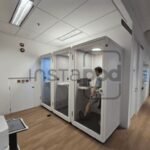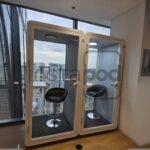No pods added to your quote request yet. Add some now for a free quote!
Deciding between a phone pod and a traditional meeting room can feel like a big choice for any business. Both options have their good points and bad points, and what’s right for one office might not work for another. This guide will help you figure out which setup makes the most sense for your team, looking at things like space, money, and how people actually work. We’ll break down the details so you can make a smart decision for your workplace.
Key Takeaways
- A phone pod gives you a quiet spot for calls or focused work without taking up much room.
- Traditional meeting rooms are better for bigger group discussions and have more space for equipment.
- Think about your office layout and how much space you really have available.
- Phone pods often cost less upfront and can be moved around easily.
- Consider how much privacy and quiet your team needs for different tasks.
Understanding Phone Pods
Defining the Modern Phone Pod
So, what exactly is a phone pod? Think of it as a personal sanctuary within the office. It’s a small, self-contained unit designed to provide a quiet and private space for phone calls, video conferences, or focused work. Unlike a cubicle, it offers a higher degree of acoustic isolation. These soundproof office pods are becoming increasingly popular as open-plan offices become the norm, and the need for quiet spaces grows.
Key Advantages of Phone Pods
Phone pods offer a bunch of benefits that traditional meeting rooms just can’t match. Here’s a quick rundown:
- Privacy: They give employees a dedicated space for confidential conversations.
- Acoustics: Designed to minimize distractions, both for the user and those around them.
- Flexibility: Many models are mobile, meaning you can move them around as your office needs change.
Phone pods are a practical solution for modern workplaces. They address the need for quiet, private spaces without requiring extensive renovations or a permanent commitment to a specific layout. This adaptability is a major advantage in today’s rapidly evolving work environments.
Ideal Use Cases for a Phone Pod
When do conference room pods really shine? Here are a few scenarios:
- Private Phone Calls: Obvious, right? But crucial for sensitive discussions.
- Video Conferencing: Provides a professional backdrop and minimizes background noise.
- Focused Work: When an employee needs to concentrate without interruptions.
- Small, Informal Meetings: A great alternative to booking a large meeting room for just two people.
Basically, if you need a quiet, private space for one or two people, a office privacy pods are a solid choice.
Exploring Traditional Meeting Rooms
Characteristics of Conventional Meeting Spaces
Traditional meeting rooms are those enclosed spaces we’ve all come to know in office environments. They’re designed for formal gatherings, presentations, and confidential discussions. They usually feature a table, chairs, and maybe a whiteboard or projector. They are built to be acoustically private, blocking outside distractions. They are often equipped with technology for presentations and video conferencing. These rooms are fixed in place, part of the building’s structure, and intended for long-term use.
Benefits of Traditional Meeting Rooms
Traditional meeting rooms provide several key benefits:
- Privacy: They offer a secure space for sensitive conversations.
- Focus: The enclosed environment minimizes distractions, helping attendees concentrate.
- Technology Integration: They can accommodate advanced AV systems for high-profile presentations.
- Capacity: They can host larger groups, making them suitable for board meetings or client presentations.
Traditional meeting rooms are great for formal meetings, client pitches, and any situation where privacy and focus are paramount. They offer a dedicated space for collaboration and decision-making, free from the interruptions of the open office.
When Traditional Meeting Rooms Excel
Traditional meeting rooms are the best choice when:
- Confidentiality is a must: Discussing sensitive information requires a secure, private space.
- Large groups need to meet: Traditional rooms can accommodate more people than phone pods.
- Advanced technology is required: Complex AV setups are easier to integrate into a fixed room.
- Formal presentations are common: A dedicated space enhances professionalism and impact.
For example, a company might use a traditional meeting room for meeting spaces to discuss quarterly earnings or to conduct performance reviews.
Comparing Space and Size Requirements
Footprint of a Phone Pod
Phone pods are designed with space efficiency in mind. Their compact size makes them ideal for offices where square footage is at a premium. A typical single-person phone pod occupies a minimal footprint, generally around 4×4 feet. Larger pods designed for small meetings might take up 6×6 or 8×8 feet. This small size allows for easy integration into existing office layouts without requiring significant renovations.
Space Needs for Traditional Meeting Rooms
Traditional meeting rooms, on the other hand, demand significantly more space. A small meeting room designed for 4-6 people might require at least 10×12 feet, while larger conference rooms can easily exceed 20×30 feet. This substantial space requirement can be a major drawback for businesses operating in expensive urban areas or older buildings with limited room to spare.
Optimizing Office Layout with Phone Pods
Phone pods offer a flexible solution for optimizing office layouts. They can be easily relocated or reconfigured as needed, allowing businesses to adapt to changing needs without the expense and disruption of traditional construction. Here are some ways phone pods can help optimize your office layout:
- Creating quiet zones in open-plan offices.
- Adding meeting spaces without major renovations.
- Providing privacy for sensitive conversations.
- Maximizing usable floor space.
Integrating phone pods into an office design allows for a more dynamic and adaptable workspace. They provide a balance between open collaboration areas and private, focused spaces, ultimately leading to a more efficient and productive work environment.
Cost Considerations for Your Business
Investment in a Phone Pod
Okay, let’s talk money. When you’re thinking about getting a phone pod, the initial investment is what usually jumps out first. You’re looking at the cost of the pod itself, which can vary quite a bit depending on the size, features, and materials. Some pods come with all the bells and whistles – fancy lighting, soundproofing, the works – while others are more basic. Don’t forget to factor in delivery and installation costs. Some companies include that, but others charge extra. It’s also worth considering whether you want to buy or lease. Leasing can lower the upfront cost, but buying might be cheaper in the long run. You can always contact InstaPod Singapore at +65 6817 0121 to inquire about roller blinds and other products.
Expenses for Traditional Meeting Rooms
Traditional meeting rooms? They seem "free" because they’re already there, right? Not so fast. Think about the initial construction or renovation costs. Walls, doors, flooring, lighting, HVAC – it all adds up. Then there’s the furniture: tables, chairs, maybe a whiteboard or projector. And don’t forget ongoing maintenance. Paint chips, carpet stains, broken chairs… it never ends. Plus, if you need to upgrade the tech – new projectors, better speakers – that’s another expense. Traditional meeting rooms can be deceptively expensive. Here’s a quick comparison:
| Expense Category | Phone Pod | Traditional Meeting Room |
|---|---|---|
| Initial Construction/Purchase | Moderate | High |
| Installation | Low | High |
| Furniture | Included/Minimal | Additional |
| Maintenance | Low | Moderate |
| Utilities | Low | Moderate to High |
Long-Term Value of Phone Pods
So, are phone pods worth it? In the long run, they can be a pretty smart investment. Because they’re modular, you can move them around if you rearrange your office, which saves on renovation costs. Plus, they’re often more energy-efficient than big meeting rooms, which can lower your utility bills. And if you ever move offices, you can take your pods with you. That’s something you definitely can’t do with a traditional meeting room. Consider the monitor brackets and other features offered by InstaPod Singapore to enhance the functionality of your pods.
Think about how often your big meeting rooms are actually used. Are they sitting empty most of the time? Phone pods offer a more flexible and efficient use of space, which can translate to real cost savings over time. They address the need for focused work and quick calls without tying up larger, more expensive spaces.
Here are some ways phone pods can provide long-term value:
- Reduced construction costs compared to building new meeting rooms.
- Lower utility bills due to smaller space and energy-efficient design.
- Flexibility to relocate pods as office needs change.
- Potential for increased employee productivity due to focused work environment.
Acoustics and Privacy Features
Soundproofing in a Phone Pod
Phone pods are all about keeping sound in (or out!). The level of soundproofing is a major factor to consider. They’re designed to give you a quiet space, whether you’re making a call or just need to focus. The walls, door, and even the ventilation system are built to minimize noise. Some pods even use special acoustic materials to absorb sound. It’s a big step up from trying to find a quiet corner in a busy office.
Privacy in Traditional Meeting Rooms
Traditional meeting rooms should offer privacy, but it’s not always a given. It really depends on the room’s design. Things like wall thickness, door seals, and even the windows can affect how well sound is contained. Plus, if the room is right next to a busy hallway, you might still hear a lot of background noise. Older meeting rooms might not have been built with soundproofing in mind, so you could end up with sound leaking in or out. It’s something to think about if you’re discussing sensitive topics.
Ensuring Confidentiality with a Phone Pod
Phone pods can really help with keeping things confidential. They’re often designed with features that go beyond just basic soundproofing. Think about things like sound-masking systems, which add a layer of white noise to make conversations harder to overhear. Some pods also have features like frosted glass or solid doors to prevent visual eavesdropping. When you need to have a private conversation, a well-designed phone pod can give you peace of mind.
It’s important to consider the specific needs of your business when choosing between phone pods and traditional meeting rooms. If confidentiality is a top priority, a phone pod with advanced soundproofing and privacy features might be the better choice.
Flexibility and Mobility in the Workplace
Relocating a Phone Pod
One of the biggest advantages of a phone pod, or office booth, is its mobility. Unlike traditional meeting rooms, which are permanent fixtures, phone pods can be easily relocated within the office as needs change. This is especially useful for growing companies that might need to reconfigure their space frequently. Moving a pod is generally a straightforward process, often involving disassembly and reassembly in the new location. This flexibility means you can adapt your office layout without major construction or renovation costs.
Fixed Nature of Traditional Meeting Rooms
Traditional meeting rooms, on the other hand, are typically built into the structure of the building. This means they are difficult and expensive to move. If your company decides to change its layout or relocate to a new office, the meeting rooms stay put. This lack of flexibility can be a significant drawback, especially in today’s fast-paced business environment where adaptability is key.
Adapting to Evolving Office Needs with a Phone Pod
Phone pods offer a practical solution for businesses that need to adapt quickly to changing needs. Consider these points:
- Scalability: Add or remove pods as your team grows or shrinks.
- Reconfiguration: Easily move pods to different areas of the office to support new projects or teams.
- Agility: Respond to changing business priorities by reconfiguring your workspace without major disruptions.
The ability to quickly adapt your workspace is a huge advantage in today’s dynamic business world. Phone pods provide the flexibility to create a workspace that meets your current needs and can easily evolve as your business grows and changes. This adaptability can save you time, money, and headaches in the long run.
Enhancing Employee Productivity
Focused Work in a Phone Pod
Phone pods can be a game-changer for individual productivity. They offer a quiet, distraction-free zone where employees can concentrate on tasks that require deep focus. Think about it: no more noisy coworkers, ringing phones, or impromptu meetings interrupting your train of thought. This is especially helpful for tasks like writing reports, analyzing data, or preparing presentations. It’s like having a personal office, but without the hefty price tag or commitment of a full-sized room.
Collaboration in Traditional Meeting Rooms
Traditional meeting rooms are still the go-to for team-based work. They provide a space where people can gather, share ideas, and work together on projects. The larger size allows for group discussions, brainstorming sessions, and presentations. Plus, the presence of a table and chairs encourages face-to-face interaction, which can be important for building relationships and fostering a sense of community. It’s hard to replicate that kind of dynamic in a small phone pod.
Boosting Efficiency with a Phone Pod
Phone pods can actually boost overall office efficiency. By providing a dedicated space for focused work, they free up other areas of the office for collaborative activities. This can lead to a more balanced and productive work environment. Plus, the availability of phone pods can reduce the number of distractions in open-plan offices, which can improve concentration and reduce stress levels. It’s a win-win for both individual employees and the company as a whole.
Having a mix of phone pods and traditional meeting rooms can create a more versatile and productive workspace. It allows employees to choose the environment that best suits their needs, whether it’s focused individual work or collaborative team projects. This flexibility can lead to increased job satisfaction and improved overall performance.
Wrapping It Up: Making Your Choice
So, when it comes down to it, picking between a phone pod and a regular meeting room isn’t super complicated. It’s mostly about what your office actually needs and how much money you’re looking to spend. If you’re short on space or just need a quick, quiet spot for calls, a phone pod is probably your best bet. They’re usually cheaper and can fit into tighter areas. But if you’ve got a bigger team, need to do presentations, or just like having a more traditional setup, then a meeting room makes more sense. Think about how often you’ll use it and what for. Both options have their good points, so just figure out what works best for your crew.
Frequently Asked Questions
What exactly is a phone pod?
Phone pods are like small, private rooms you can put inside a bigger office. They are great for making phone calls, doing focused work, or having quick, private chats without bothering others.
What’s a traditional meeting room?
Traditional meeting rooms are the usual, bigger rooms found in offices. They are good for larger group meetings, presentations, and when many people need to get together at once.
Are phone pods cheaper than regular meeting rooms?
Phone pods usually cost less to buy and set up than building a whole new meeting room. They also save money because they don’t need as much space or big changes to your office.
Can I move a phone pod once it’s in place?
Yes, phone pods are built to be moved! Many have wheels or are easy to take apart and put back together. This means you can change your office layout whenever you need to.
How good are phone pods at blocking sound?
Phone pods are designed to be very quiet inside. They have special walls and materials that block out noise, so your conversations stay private and you can concentrate better.
How do I pick between a phone pod and a traditional meeting room?
The best choice depends on what your business needs. If you need small, quiet spots for individual work or calls, and want to save space and money, a phone pod is great. If you often have large group meetings, a traditional meeting room might be better. Many offices use both!




